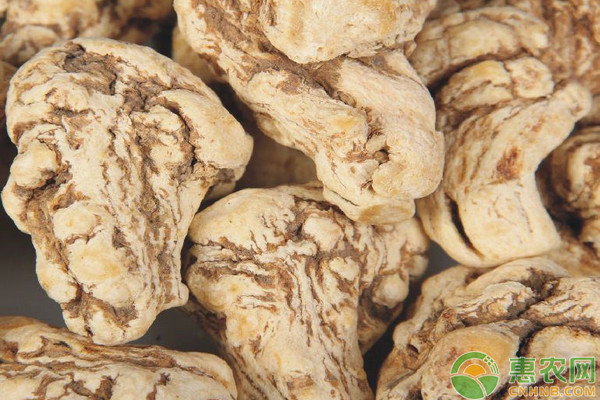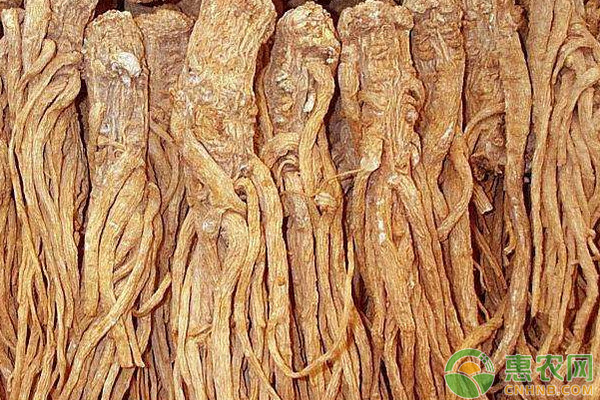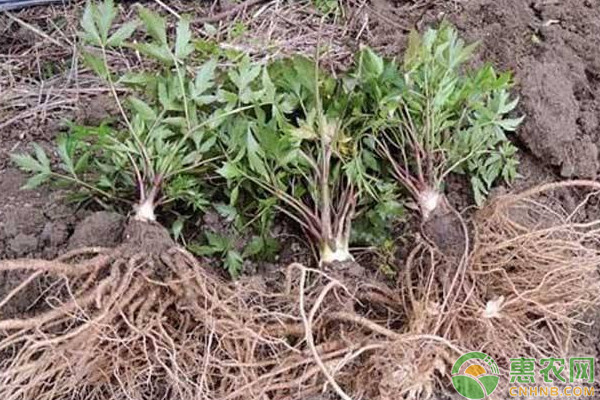How is Angelica planted? China's Shaanxi, Yunnan, Sichuan, Gansu and other provinces have planted, Angelica is a traditional Chinese medicine that most people are familiar with, can treat irregular menstruation, intestinal dry constipation, etc., together to learn the key points of cultivation techniques of Angelica.

I. Morphological characteristics and growth habits
(1) Morphological characteristics
Angelica is a perennial herb, flowering from June to July, fruiting from June to August. The flower is white and the main root is short.
(2) Growth habits
When belonging to alpine plants, like fertilizer, fear of cockroaches, fear of high temperatures, require cool, humid climate conditions. Angelica is yin and yin in the second year of transplanting.
Second, cultivation techniques
(1) Nursery
1. Seed selection: seed quality: purity ≥ 80%, clarity ≥ 80%, water content ≤ 15%, germination rate ≥ 50%; appearance orange to yellow brown, no mildew, with the color of this variety.
2. Seed treatment: Remove seeds such as impurities, sorghum seeds, mildew, and insect damage before sowing. Soaking seeds in warm water: place the seeds in warm water of 30 ~ 40 °C, stir while stirring, remove the sorghum seeds floating on the water surface, soak the full seeds of the sinking bottom for 24h, remove the germination, and when the seeds are white, sowing.
3. Selection of seeding: The seedbed should be selected in the leeward, shaded hillside or wasteland. In April, the weeds are burned and turned to the ground. The hoe is smashed and planted in the sorghum. About 36.7 kg of seeds are needed for 666.7 m2. Spread evenly on the deep-turned flat seedbed, covering 3cm of fine soil; then cover the grass 3cm to ensure the transmittance is ≤10%.
4. Management of seedbed: After 20 days of sowing, the seedlings are released. When the seedlings are mixed and the height is more than 1cm, that is, 40d after sowing, the grass must be gently picked up once and the weeds are removed. When the seedling height is 3cm and the cotyledons are 3 pieces, the soil is loosened once and the weeds are removed. After the seedlings are basically out, the grass can be gently removed. Pull the grass and loosen the soil once more to promote its growth.
5. Seedling storage: transplanting can be transplanted in autumn after the seedlings, such as transplanting in the following year. In the cold dew to the frost, the seedlings will be removed, and the leaves will be removed and tied into a small 8cm diameter (0.15~0.2kg), which will be slightly dried for winter storage.
There are two ways to store seedlings:
(1) 窖è—(湿è—): Choose a place that is dry and cool without a rat hole. If the seedlings are used, the square or round pit is dug out, and the single layer of the seedlings is placed at the bottom of the pit. The semi-dry soil is 3~5cm. Store 6 to 7 layers layer by layer, stacking soil 30~40cm above it, above the ground, forming a turtle's back to prevent water accumulation. After that, you should check it at any time to prevent decay. The seedlings stored in this method have poor drought resistance.
(2) Dry storage (pit planting): In a smoke-free and cool room, adobe is used to build a 1m square earthen pond. The pool is covered with 5cm of soil, and the seedlings are placed 1 inch from the inside and the seedlings are inward. In addition, leave a gap of 6 to 8 cm between the seedlings, and fill the pool with a layer of thickened soil, and the top is made into a fish ridge. The seedlings stored in this method have strong drought resistance.
Strong seedling standard: seedling age 70 ~ 90d, the ground is strong and vigorous, the leaves are dark green; the root seedlings are free from pests and diseases, no mechanical damage, smooth surface, the middle diameter is 3 ~ 5mm, the lateral roots are less, and the seedlings weigh 40 ~ 70g.

(2) Colonization
Land preparation for ridges: before the high-quality farmyard manure, the land is turned over 30~40cm. The ridge planter needs to make a ridge: the ridge width is 60-80 cm, the ridge height is 23 cm, and the ridge distance is 33 cm. Transplanting time: In the middle and late March, the general spring equinox begins, the Qingming plant is planted, and the valley rain sweeps.
There are two kinds of transplanting methods: 1 flat planting: on the whole plot, digging pits and punching holes, the hole distance is 25cm, the hole depth is 18~22cm, the diameter is 12-15cm, and each hole is 1~2 seedlings. In the hole, compact with soil; cover the soil 2cm, cover the head, but not too thick. 2 ridge planting: generally used when there is insufficient heat and irrigation conditions. The cultivation method is the same as that of flat planting.
Planting density: Regardless of flat planting or ridge planting, the number of seedlings per acre should be maintained at 6,000-7,000 plants.
(3) Field management:
1. Fertilization: Organic fertilizers include compost, manure, manure, biogas, green manure, crop straw fertilizer, peat, cake fertilizer and other farmyard manure and commodity organic fertilizer, organic compound fertilizer. Includes humic acid fertilizers. Fertilizer: including nitrogen fertilizer, phosphate fertilizer, potassium fertilizer, sulfur fertilizer, calcium fertilizer, magnesium fertilizer and compound (mixed) fertilizer. Microbial fertilizers include microbial preparations and microbial treated fertilizers. Nitrogen-based inorganic fertilizers that are prohibited from use; unfertilized human and animal excrement; fertilizer products that are not approved for registration. Municipal solid waste or garbage containing heavy metals, rubber and hazardous substances that have not been harmlessly treated. Fertilization method base fertilizer: combined with land preparation deep-turning, 666.7m2 high-quality farmyard manure 3000kg or more, appropriate increase of bauxite application, mixed with fertilizer, scalar 15kg, N:P:K ratio of 1:1:1.
2. Topdressing: Topdressing is required twice during the whole growth period, and topdressing is performed once when the seedling height is 10-15 cm, the total active ingredient is 6 kg/666.7 m2, N:P:K is 1:1:1; when the seedling height is 25-30 cm Topdressing 1 time, the total active ingredient is 8kg/666.7m2, and N:P:K is 1:1:2. Inorganic fertilizer should not be applied within 30 days before harvest.
3. Miao Ding Miao: When the seedlings are incomplete, timely replenish the seedlings; when the seedling height is more than 5cm, combine the first cultivating seedlings; when the seedling height is 8cm, set the seedlings according to the plant spacing of 10~15cm.
Control bolting: Generally, the bolting plants in the production area account for 10%-30% of the total, and in severe cases, 40%-70%, which often brings certain losses to production. Early bolting often has a certain relationship with seeds, seedlings and cultivation conditions in the second year, so the following questions should be noted:
One is to choose a good seed. In the production, the seeds of the 3-year-old Angelica should be used for seeding, and it is appropriate to harvest the seeds when they become pink and white.
The second is to cultivate good seedlings. Choose wet and fertile environment for nursery, pay attention to multi-burning smoked soil during seedling cultivation, fine soil preparation, timely sowing, proper close planting, fine sowing, ensure the whole seedling, make the emergence of seedlings neat, grow strong; choose rainy days to uncover grass, avoid seedlings to die Appropriately apply nitrogen fertilizer, delay harvesting, do not dig the plant, and avoid drying the plant before storing the plant. All of the above measures can reduce the bolting rate.
The third is to choose a nursery. When breeding seedlings, the soil should be selected to be moist, and the slopes above 2000 meters above sea level.
4. Intercropping and weeding: The time and number of cultivating time is 5 cm when the seedling height is 5 cm, and the first cultivating and weeding is carried out. It is required to be shallow and fine, and the soil is not buried. When the seedling height is 10 to 15 cm, the second cultivating is carried out, and it is required to be deep, clean, and cultivated for rooting. In the future, the weeds in the field will be removed in time. It is prohibited to use all herbicides that are sensitive to dicotyledons.
5. Pests and their prevention and treatment:
(1) Diseases:
Root rot: also known as rotten root disease. The pathogen is a semi-known fungus in fungi. Mainly harmful to the roots. Most of the fields occurred in May, and the number of underground pests and low-lying stagnant water was seriously ill. After the onset, the leaves were yellow and the root tip and root of the plant began to turn brown and water stains. Then the black roots fell off. The roots of the plant were rust yellow. After decay, the fibrous material remained and the plants died.
Control methods: 1 soil disinfection before planting, using 70% chloral nitrobenzene per acre; 1 selection of disease-free seedlings, soaking with 1:1:150 Bordeaux mixture, drying and planting; 3 pulling out diseased plants, in disease A lime powder is applied to the hole, and the ward is completely watered with 2% lime water or 50% carbendazim 1000 times to prevent spread.
Brown spot: The pathogen is a semi-known fungus in fungi. Harm the leaves. It lasted from May to the harvest. It is easy to develop under high temperature and high humidity conditions. In the early stage of the disease, brown spots appeared on the leaf surface. After the lesion was enlarged, there was a chlorotic halo around the periphery, the edge was reddish brown, and the center was grayish white. In the later stage, small black spots appeared in the center of the diseased plant, and the disease progressed. Most of the leaves were reddish brown, and finally the whole plant died.
Control methods: 1 clean the countryside in winter, completely burn the sick tissue, reduce the source of bacteria; 2 remove the diseased leaves at the beginning of the disease, spray 1:1:150 Bordeaux mixture; spray after mid-35 1:1 1:50 Bordeaux mixture, every Spray once every 7 days - 10 days or spray 6 times 3 times - 3 times with 65% of sensitized zinc.
(2) Pests:
Peach big tail owl: also known as "greasy worm", belonging to the family Homoptera. Mainly for the young shoots of Angelica. In the spring, the peach and plum trees are moved into the field, causing the tender leaves to become thick and fist-shaped.
Control methods: 1 Angelica should be away from peaches, plums and other plants to reduce the source of insects; 2 when found aphids can be sprayed with 20% of pyrethroid 3000 times liquid - 4000 times liquid.
Yellow wind butterfly: also known as "Fen Swallowtail Butterfly", is a Lepidoptera. The larvae are harmful to the leaves of Angelica, biting into a missing or only petiole.
Control methods: 1 In the early stage of larvae, the artificial killing can be carried out; 2 when the number is high, spray 80% dichlorvos 1000 times liquid - 1500 times liquid or 300 times liquid of blue worm. Once a week, 2 times - 3 times in a row.
Kind of rope: also known as "the mantle", belonging to the family Hymenoptera. The larvae are harmful to the roots. In the seedling stage of Angelica, the roots are bitten into the roots, and the roots are hollowed out or caused to rot, and the plants die.
Control method: 1 kind of flies have the habit of tending to unfertilized compost and spawning. Therefore, fertilization should be done with composting, and covered with soil after application to reduce the spawning of the flies; 2 found that the flies are harmful, 40% dimethoate 2000 times or 90 can be used. % trichlorfon 800 times liquid rooting, once every 5 days - 7 days, 2 times - 3 times.

7. Harvesting and processing
(1) Harvest: Angelica can only be harvested after 3 years of planting. When the harvesting time is in early October, when the leaves of Angelica sinensis have turned yellow, the upper part of the ground is cut to make the sun shine to the ground, and the roots are matured. Angelica is harvested in late October. Generally, the yield per mu of dried angelica is about 150 kilograms, and that of high-yield fields can reach 350 kilograms to 400 kilograms.
(2) Processing: After the digging is collected, the soil will be shaken in time, the roots will be picked out, and the petiole will be removed. After the water has evaporated slightly, the angels will be tied into small pieces with wicker and placed on the pre-stacked scaffold. The firewood of the firewood smokes the angelica until the epidermis is reddish or golden yellow (about 15 days of smoke), and then roasted with coal to dry. The quality of Angelica depends on the production area, cultivation techniques, early and late digging of Angelica and the technology of smoked and dried.
8. Seeding
The angelica in the planting area is not excavated. In the early spring, weeds are removed. Generally, no management is carried out. In mid-August, when the seeds are changed from red to pink, the seeds are harvested in batches, and the seeds can be collected from 50 kg to 100 kg per mu. The harvested ears are tied and placed in a cool place to dry, dried and threshed in winter, stored in a cool, ventilated and dry place, can not be heated, damp, the second year of sowing and the third year of planting will greatly reduce the germination rate.
The above is the whole content of the cultivation techniques of Angelica, which is to be discussed in Xiaobian today. Welcome the friends of the farmers to come to Huinong.com!
Antihypertensive Ingredients,Moringa Leaf Extract Powder,Organic High Pure Moringa Powder,Water Soluble Moringa Oleifera Powder
Xi'an XJeson Biotech Co., Ltd , https://www.xjesonbio.com